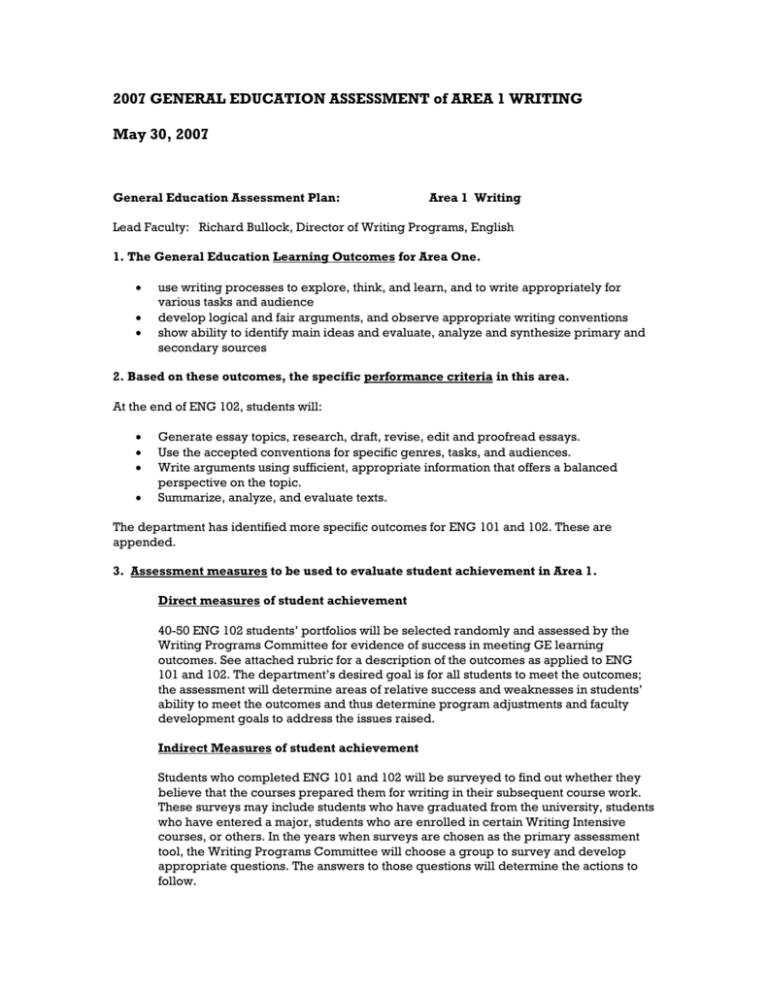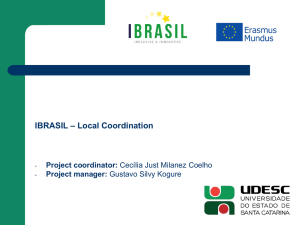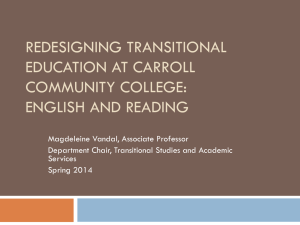Writing - Wright State University
advertisement

2007 GENERAL EDUCATION ASSESSMENT of AREA 1 WRITING May 30, 2007 General Education Assessment Plan: Area 1 Writing Lead Faculty: Richard Bullock, Director of Writing Programs, English 1. The General Education Learning Outcomes for Area One. use writing processes to explore, think, and learn, and to write appropriately for various tasks and audience develop logical and fair arguments, and observe appropriate writing conventions show ability to identify main ideas and evaluate, analyze and synthesize primary and secondary sources 2. Based on these outcomes, the specific performance criteria in this area. At the end of ENG 102, students will: Generate essay topics, research, draft, revise, edit and proofread essays. Use the accepted conventions for specific genres, tasks, and audiences. Write arguments using sufficient, appropriate information that offers a balanced perspective on the topic. Summarize, analyze, and evaluate texts. The department has identified more specific outcomes for ENG 101 and 102. These are appended. 3. Assessment measures to be used to evaluate student achievement in Area 1. Direct measures of student achievement 40-50 ENG 102 students’ portfolios will be selected randomly and assessed by the Writing Programs Committee for evidence of success in meeting GE learning outcomes. See attached rubric for a description of the outcomes as applied to ENG 101 and 102. The department’s desired goal is for all students to meet the outcomes; the assessment will determine areas of relative success and weaknesses in students’ ability to meet the outcomes and thus determine program adjustments and faculty development goals to address the issues raised. Indirect Measures of student achievement Students who completed ENG 101 and 102 will be surveyed to find out whether they believe that the courses prepared them for writing in their subsequent course work. These surveys may include students who have graduated from the university, students who have entered a major, students who are enrolled in certain Writing Intensive courses, or others. In the years when surveys are chosen as the primary assessment tool, the Writing Programs Committee will choose a group to survey and develop appropriate questions. The answers to those questions will determine the actions to follow. The General Education Student Learning Outcomes Evaluation Form will be distributed on a regular basis to selected Area 1 courses as determined by UGEC. The results will be tabulated and submitted to the appropriate dean’s office. The results of the survey will be provided to the appropriate college committees, chairs, and instructors. Qualitative evaluations of student achievement Each quarter, faculty teaching ENG 102 will read two portfolios randomly chosen from previous quarters’ ENG 102 students and meet to discuss the portfolios’ merits and problems and the extent to which each meets the program’s learning outcomes. Faculty teaching ENG 101 will do the same, with two previous 101 students’ portfolios. The discussion that takes place in these meetings will provide the basis for a report outlining faculty perceptions of the success of the program in meeting the outcomes and their perceptions of potential areas of need, along with a plan for addressing those areas. Quantitative evaluations of student achievement Each ENG 102 instructor will be paired with another ENG 102 instructor. The instructors will be given lists of 5 randomly-chosen students’ names from their section. Those 5 students’ portfolios will be assessed by their instructor-partner and then by the instructor of their section. Afterward, each instructor will complete a questionnaire asking them to rate the degree to which the portfolios meet ENG 102 outcomes (see attached rubric) on a 1-5 scale. The results of that assessment (of 20% of the students completing ENG 102—5 students from each section of 25) will be compiled and analyzed by the Writing Programs Committee, which will use the results to develop an action plan. The General Education Student Learning Outcomes Evaluation Form will also provide quantitative data for assessment purposes. 4. Assessment Schedule to be used Each year: Qualitative and Quantitative measures, focusing on all 3 outcomes and criteria Every 4 years, alternating every two: Direct and Indirect measures, again focusing on all 3. (This has turned out to be a fiction, as we have found that our assessments must be determined by our previous assessment-driven work, not an arbitrary schedule.) 5. Collection, storage, retrieval, evaluation of data The department’s Writing Programs Committee is responsible for ENG 101 and 102. Specifically, the English Department’s Bylaws describe the makeup and functions of the committee as follows: i. Writing Programs Committee Members: The Director of Writing Programs (chair) The Director of Graduate Studies (ex-officio voting member) The Director of the Writing Center (ex-officio voting member) Four faculty elected by the department's voting membership, all of whom should be active in one or more of the department writing programs A teaching assistant elected by the teaching assistants in the graduate program Duties: Develop policy, program and course recommendations related to writing courses (except those in creative writing) Oversee writing program curricula Send undergraduate and general-education related curricular recommendations to the Undergraduate Committee Send recommendations involving graduate courses to the Graduate Committee Periodically evaluate the performance of Lecturers in composition, and send recommendations regarding the renewal of Lecturers' contracts to the Advisory Committee Review all applications for part-time writing positions The Director of Writing Programs will collect the data from the Quantitative and Qualitative measures until the Writing Programs Committee reviews and evaluates it and recommends actions based on it. A member of the Writing Programs Committee, working with the Director of Writing Programs, will collect and store the data from the Direct and Indirect measures until the Writing Programs Committee reviews and evaluates it and recommends actions based on it. ENG 101 and 102 General Education Program Assessment, May, 2007 History: In 2005, the Writing Programs Committee spent the fall quarter conducting its first required General Education program assessment. We looked at the program through three different lenses, one more than required by our GE Assessment Plan: Quantitative Measure: A tallying of the scores from the portfolios traded and evaluated by ENG 102 instructors during 2004 and 2005. This totaled over 600 portfolios that were evaluated on 17 different criteria. Qualitative Measure: A summary of the scores given by 5 ENG 102 norming session participants, using the same 17-criteria rubric. Direct Measure: The scores given to 40 randomly-chosen ENG 102 portfolios, each of which was read by 2 members of the committee and scored using the GE criteria. The 3 assessments showed a consistent finding: across the board, the writing faculty found that the writing students produced at the end of ENG 102 was: Blah. Mediocre. Passable, but barely. Discussion of the assessments led to the framing of a key question for the committee and the program’s faculty: How can we keep what we like about ENG 101 and 102 (its welcoming, nurturing stance toward students and emphasis on helping them succeed in the courses) and establish more rigor and produce better results? To answer that question, the committee agreed to Examine the current 101/102 program, and Investigate possible alternatives to the current program. Through the 2005-2006 and 2006-2007 school years, the department has been pursuing this question. As results of focus groups (2006) and research into placement efficacy and review of the program (2006 and 2007), the department’s Writing Programs Committee has done the following: Writers Studio: To provide additional help for students in ENG 101, a new course was implemented for fall, Writers Studio. A one-hour, pass/unsatisfactory course, Writers Studio offers small-group tutoring and instruction to students whose instructors determine, through a diagnostic reading and writing sample administered during the first week of the quarter, that they need extra help to succeed. The Senior Vice President for Curriculum and Instruction graciously provides funding for the course, which is taught by adjunct faculty from both the English Department and the DEV program. In fall quarter, 2006, the course was voluntary, with placement determined through a personal essay. Almost no students volunteered, and the placement instrument was declared to be too inexact to be useful. For winter quarter 2007, the instrument was revised to include the reading of an academic essay and the writing of a summary of it and an essay based on it. Instructors found this instrument to be very accurate and useful. However, since the program was still voluntary, few students registered for it. In spring, 2007, the same instrument was used, and the course was made mandatory; more than 60 students registered (out of 100+ referred). We think we have the parts in place now, from the student end. For fall 2007, we will use the same procedure, but have developed forms to facilitate ongoing communication among the Writers Studio instructors and ENG 101 instructors, something that was spotty this year. The writing programs committee is also exploring the possibility of having Writers Studio be offered through the University Writing Center, where the course could lend increased academic legitimacy to the Center and also be expanded to include Writing Intensive courses in General Education and in the majors. Placement: A new placement instrument, Online Directed Self Placement, was implemented for the students entering the university in fall, 2006. During the summer, a quick assessment of enrollments determined that the cut score was too low, so almost no students were placed into DEV. The scores were adjusted in August, and some students were re-placed appropriately, but several sections of DEV writing had to be cancelled due to poor enrollment. Their instructors were offered Writers Studio sections, as Writers Studio was developed to help students who would have otherwise taken DEV courses. Using Fall quarter, 2006 data, we compared the grades of students finishing ENG 101 with their ACT verbal scores and their Online Directed Self Placement (ODSP) scores. The result: ACT scores were little better than chance in predicting students’ success in ENG 101. ODSP scores fared a bit better: students placed into ENG 101 who completed ENG 101 had an 85% chance of getting a C or better in the course, while students who placed into a DEV course but ignored their placement and took ENG 101 had only a 66% chance of earning a C or better. Still, the committee felt that was too inaccurate and began looking at alternatives. In December, 2006, however, the Ohio Legislature passed the Ohio Core, which dramatically altered the placement landscape with two new rules: one, it mandated a single, uniform placement procedure for all state postsecondary institutions; two, it mandated the end of state subsidies for developmental courses at almost all state institutions. So control over our placement procedure is being lost, while the stakes for students and institutions have gone up considerably. (The Board of Regents has proposed using the ACT as the instrument; our analysis suggests that it’s a poor tool, and ACT itself admits that its ability to predict success is about 75%--too low for a tool that could keep students from matriculating at four-year universities, or place them into ENG 101 wrongly.) We responded by closely examining our first-week diagnostic (see above), comparing it with a very similar procedure used by the University of Cincinnati. We developed an online diagnostic procedure like UC’s, with the goal of using it for two purposes: to offer students placing into DEV courses a way to demonstrate that they have the skills to succeed in ENG 101 (and so avoid having to take DEV courses at Clark State or another 2-year school or branch); and to give ENG 101 instructors access to students’ diagnostics before the quarter begins, so their first week is not dominated by the diagnostic. Ultimately, we agreed to table this proposed structure until the uniform placement procedure we must follow is announced. First-Year Writing: Currently, GE Area 1 requires students to complete ENG 101 and 102. The Writing Programs Committee is recommending to the department that we do the following to revise and expand the program: Rename ENG 102 as ENG 103. Create a new course, to be given the ENG 102 number, that students receiving a D or F in ENG 101 be placed into. They will receive instruction both in areas of writing in which they showed weaknesses in ENG 101 and in areas to prepare them for ENG 103. (Students receiving an X in 101 will have to repeat it, as they do now.) Create another new course that combines ENG 101 and 102, for students whose writing abilities are strong enough that one course will be enough. Institutionalize Writers Studio as a corequisite for ENG 101 for some students.







